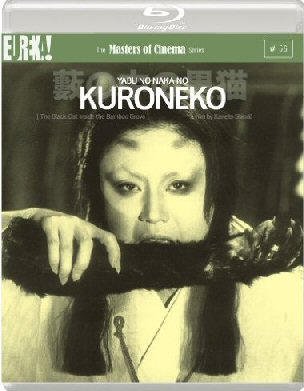
(A.k.a. YABU NO NAKA NO KURONEKO; THE BLACK INSIDE THE BAMBOO GROVE)
Feudal Japan in the 17th Century. War has led to the country becoming a largely lawless one, where even hungry soldiers are prone to pillaging quieter villages.
A mother, Yone (Nobuko Otowa), and her daughter-in-law Shige (Kiwako Taichi) are the latest victims of such an unprovoked attack. Their humble hut dwelling is ransacked by starving soldiers who eat all their food, and then take it in turns to rape the pair. They leave, setting the hut alight and leaving the women to die inside it.
As the flames subside, a black cat happens upon the scene and begins licking at the women's wounds. Suddenly, life starts to twitch in their bodies once more...
A few nights later, at the entrance of a village known as Rajo Gate, Shige appears as a spectral figure to one of the samurais. She tells him she's too frightened to walk home alone through the nearby bamboo grove, as she has heard of robbers working in the area. Appealing to his ego, the samurai agrees to accompany her back to her hut - where she and her mother-in-law, both of whom now sport unsightly eyebrow-type shadows across their foreheads, welcome him in for supper.
The samurai recognises the pair of women, but can't quite place them. They get him pissed on sake, and then the daughter runs around him flirtatiously, encouraging him to give chase. This he does, while the pounding of distant drums on the soundtrack grow closer to let us know, if not him, that things are about to turn nasty. Sure enough, his cavorting with the comely Shige ends in her taking large vampiric bites out of his throat.
The next evening, Yone and Shige perform the same trick on another of their murderers. And then, the night after that, another.
All of which garners the attention of a local priest who orders the leader of the samurais, the amusingly disrespectful Raiko (Kei Sato), to find a soldier brave enough to take on these "ghosts". Enter Gintoki (Kichiemon Nakamura), a fearless warrior recently returned to the village following some energetic sparring in the paddy fields. He's so hard he even carries the head off his nemesis around with him. And he only talks in barks, of course.
But is he any match for a couple of cat-vampire ghosts...?
Sounds ridiculous, doesn't it? But KURONEKO is as stylish as it is bold for its time, as steeped in visual metaphor as it is rich in literal sex and horror.
Kaneto Shindo's KURONEKO is based loosely on a traditional Japanese fable commonly known as "The Cat's Return", and was conceived as a companion piece to his earlier commercial hit ONIBABA.
Whereas 1965's ONIBABA - as brilliant as it remains to this very day - fuses folklore with psycho-sexual drama and truthfully only flirts with the horror genre during its pitch-black final stages, 1968's KURONEKO is a more brazenly supernatural affair. It's just as erotically charged, and shares its more famous companion's stunning aesthetic qualities, but may well appeal more to readers of this site by virtue of its more overt genre leanings.
Certainly, there is an eerie atmosphere achieved from an early stage which persists throughout. And the spooky set-pieces really do reach fever pitch upon occasion, Shindo ratcheting up the tension with the aid of Hikaru Hayashi's luminous score and some explicit violence. But none of this robs the film of its political allegory (class divides, familial obligations and loyalty still concern Shindo, as they do in his other works - THE NAKED ISLAND, TREE WITHOUT LEAVES etc) or visual splendour. We have cinematographer Kiyomi Kuroda, at the top of his game, to thank for the latter.
Eureka! released ONIBABA onto blu-ray at the start of 2013, so it's fitting that they now follow it up with the UK HD premiere of KURONEKO.
The film looks predictably superb in an MPEG4-AVC codec which presents it uncut in full 1080p HD, preserving the original aspect ratio of 2.35:1 and enhancing it for 16x9 televisions.
Blacks are solid, images are clean and depth is greatly amplified above the older DVD transfer. Contrast is strong throughout, light grain convincingly combats any potential accusation of judicious DNR and detail has never been so defined. The print is mostly clean for a 1968 film, making this new restoration a satisfying one. Some softness here and there and occasional rough-looking sequences can't detract from the overall success of this transfer.
Japanese 2.0 audio has been given the Master HD treatment and proffers a gratifyingly hiss-free, clear playback as a result. Newly translated optional English subtitles are well-written and easy to read throughout.
The disc opens to a simplistic static main menu page. From there, a pop-up scene-selection menu allows access to the film via 13 chapters.
The only on-disc extra is the film's original two-and-a-half minute theatrical trailer, presented in Japanese with optional English subtitles. It's spoilerific, but it's fun.
The set is concluded by a 32-page collectors' booklet which really is a huge bonus feature in itself. Beautifully designed and furnished with excellent monochrome stills throughout, it kicks off with excellent film notes from Doug Cummings. Following that we get a substantial interview with Shindo from 1972, and notes on KURONEKO's transfer.
Kaneto Shindo's KURONEKO stands the test of time as an ambient, visually splendid horror film. It's perhaps not quite as sexually charged as its companion piece ONIBABA, but does offer more supernatural content as compensation.
The film looks good on Eureka!'s blu-ray, making this a sound addition to any horror fan's HD collection.
Review by Stuart Willis
| Released by Eureka |
| Region B |
| Rated 18 |
| Extras : |
| see main review |